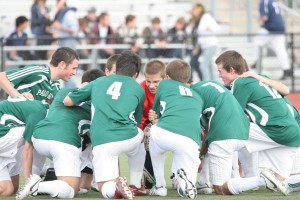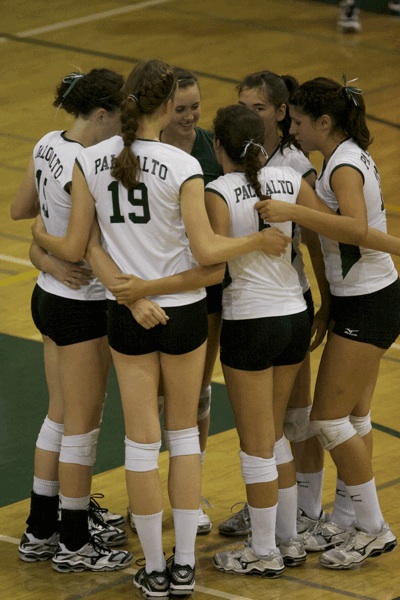With less than three minutes left on the clock, the score tied, the players sprint down the field in attempt to defend the goal. The whistle echoes in their ears as a foul is called against their defender, resulting in a free kick. As the opposing team kicks, the ball smacks a defender’s head and he redirects it up into the air towards his own goal. The goalie, ready to block the ball on the other side, dives to prevent the goal, however, the ball soars past his hands and is caught by the net. The players drop to the ground in despair, now one goal behind after their own teammate scored in the Central Coast Section semfinals.
The captains scream at their teammates to get up and off the ground and to continue playing hard for the few remaining minutes left on the clock. As they lift themselves up and wipe off the tears running down their faces, they jog to the middle of the field to restart the game. The offense tears down the field and the ball glides out of bounds. As a midfielder flips the ball onto the court, the ball manages to slip into the opponents.
With the score now tied, the team captains encourage their teammates to keep their energy up throughout overtime. A forward speeds through the opposing defense and propels the ball into the goal, winning the game for his team. The coach applauds his players for their excellent effort and tough win in the semi-finals. The athletes look up to their captains as they join their coach in praise.
Team captains lead teams in every sport at Palo Alto High School. They acquire these positions through various forms of selection and each hold different responsibilities. Some coaches select the captains that they know are trustworthy and responsible, while other teams elect a leader by a vote.
“This year there was a team wide vote,” varsity cross-country runner Andrew Stober (’10) said. “Everybody who wanted to run for captain nominated themselves.”
Both the girls’ and boys’ cross-country teams each have four captains who lead the varsity and junior varsity teams. Every runner, regardless of grade, voted in an election for his or her respective captains. With a freshmen majority on both teams, the nominated girls and boys who swayed the freshmen with their speech won the election.
“Our coach had people who wanted to be captains stand up and each of them had to tell us [the team] why they would be a good captain,” junior varsity runner Nora Rosati (’13) said. “I chose [who to vote for,] based on what they told me. I chose the people based on wheather or not they were able to speak out and grab my attention.”
Many varying opinions surround the issue of picking captains. Supporters of team elections believe that the players should pick their own captains to lead their team. Critics disagree and say that it is unfair for teammates, especially freshmen, to pick their captains by basing their vote solely on speeches instead of other attributes, like consistent performance and personality.
“The captains are for the whole team, it’s not specific varsity or frosh-soph,” Stober said. “Captains act more as leaders to the underclassmen and as an example to the rest of the team.”
Like the cross-country team, other teams also use the method of election in choosing their captains. At the beginning of each season, the girls’ lacrosse team holds elections after the junior varsity and varsity teams have been selected.
“I let the girls vote,” girls’ varsity lacrosse head coach Jen Gray said. “It is a secret ballot so everyone feels free to vote for who she really wants, then the top three nominees are the captains.”
With very few “mistakes” of choosing bad captains in Gray’s nine years of coaching, she remains firm in her choice to hold a team election.
“I leave everything up to the players,” Gray said. “Anyone on the team can be nominated. I believe that if the team thinks a freshman is qualified to be its leader, than that’s it. I have never seen a team make the wrong decision in its leaders.”
Even players that lost in an election are welcome to step up and lead by example even without the official title of captain in every sport.
Other coaches, for such sports as girls’ tennis, appoint captains regardless of the team’s consensus. Wrestling head coach David Duran is a strong advocate of coaches picking captains.
“They emerge, so the coaches know who they are and we get together and pick them,” Duran said. “We wouldn’t select them if we didn’t think they would be successful.”
Cross-country coaches appointed captains during the 2008 season because they felt there were only two obvious choices: the only two seniors on varsity.
“This year we did a team vote and its hard doing that, especially with freshmen and sophomores, when a lot of them don’t even know each other let alone the older guys,” boys’ cross-country head coach Joe Ginanni said.
This year, however, Ginanni decided to hold a team election because of the many seniors on varsity to choose from and the difficulty posed by the decision.
“It really depends on the group,” Ginanni said. “The reason we had a vote this year was because our entire varsity team was seniors and it was too hard for us to pick a captain because all seven [varsity runners] could’ve been captain, so that was why we decided to take a vote, but I guess it kind of depends year to year what we want to do as far as selecting captains.”
Badminton head coach Kara Prentice allows captains to emerge from the team without a formal election or appointment.

“I use the non-method, and I have never needed to change the process to an actual election of captains because it has always seemed to work out,” Prentice said. “There will be a few players, usually seniors, that will take on a role of captain, but anyone that wants to be more involved is welcome to assert themselves as such.”
Many teams not only pick captains through various selection processes, but also have different levels of choosen captains. In some sports, for example cross-country and track and field, the varsity and junior varsity teams are closely related and have one set of captains between them. Other teams, such as volleyball and football, have separate captains for varsity and junior varsity.
Badminton follows cross-country’s lead by having one set of captains for all players to follow.
“In badminton, there is no definitive line between varsity and JV, so the whole team is always being represented,” Prentice said.
Some players, mostly underclassmen, do not like the lack of young captains because their voices are easily lost.
“If there was a freshmen captain, information would be relayed more smoothly, Rosati said. “There should only be a freshmen captain if the other captains can work well with a freshmen because the upperclassmen captains would still be the boss.”
Most teams, such as girls’ lacrosse, have separate captains for both the varsity and junior varsity teams.
“There are three varsity and three JV captains,” Gray said. “They represent their teammates to their coaches, the refs, and their opponents.”
Football and basketball also follows girls’ lacrosse by having separate captains for the different levels of play.
Captains’ responsibilities also vary for every sport. These responsibilities range from monitoring players skills and their game to assisting player’s mental growth both on and off the field.
“I expect them [the captains] to support the coaches in practice and in games in terms of setting the tone of practice and reinforcing what we are teaching,” Gray said. “I expect them to be open and available for any players to come to in case she doesn’t feel comfortable coming directly to the coaches. I expect them to be mentors and always lead by example, on and off the field. They are responsible for addressing any team tension or conflict among members. If they do not resolve the issue, I may step in, but I like them to try to resolve it amongst themselves first. I expect them to be motivators.”
Often, captains lead warm-ups and stretches before games and practices as they get their teammates ready. They are also in charge of organizing their team, making sure that practice and game times are clear so that everyone shows up.
“We read out the lineup at the start of every match,” three year varsity girls’ tennis captain Gracie Dulik (’10) said. “We give pep talks to the team to get everyone pumped up and we lead stretches.”
Captains’ jobs vary from sport to sport. On some teams they play a crucial role of unifying the team and helping improve players, while in other sports they lead by example alone. In many sports such as football, lacrosse and basketball captains also talk to the referees throughout the game.
“They are supposed to lead at practice and during the game,” Anderson said. “If there is a penalty the referee with ask the captain if they want to decline or accept.”
Despite many differences from the form of selection to the respective responsibilities captains unify players across Paly campus. During every game and every practice in every sport, captains help players focus and push harder to better themselves both physically and mentally.
After a strong win after a long game competing through overtime, the players gear up to face another team while the captains push them to exceed any expectations.




